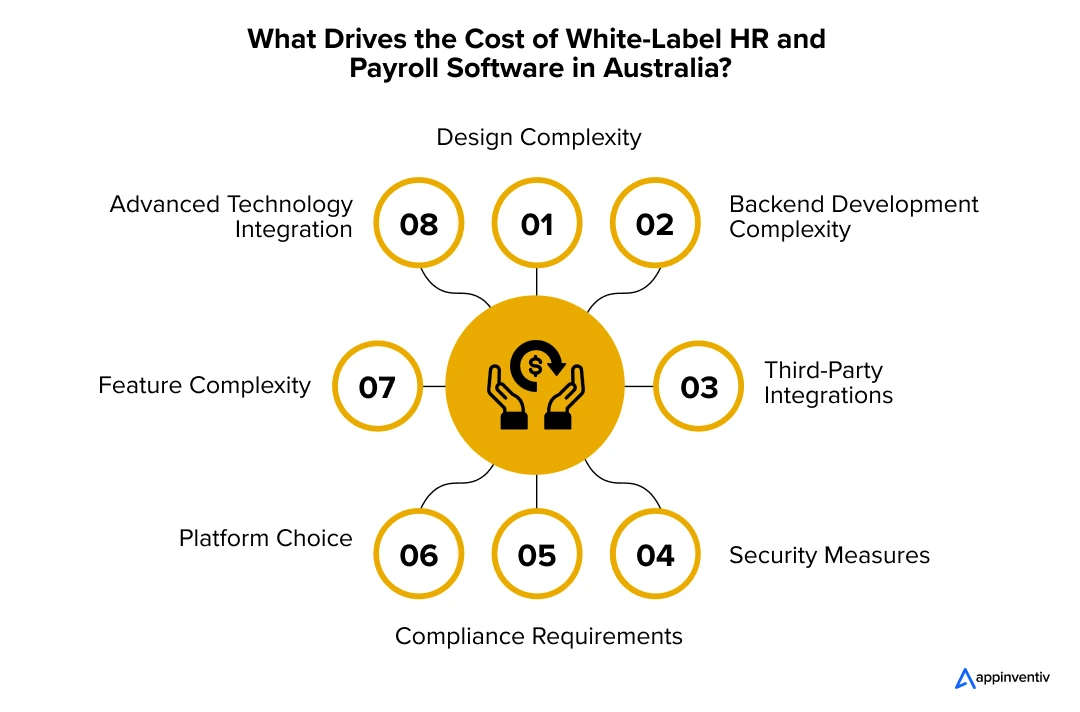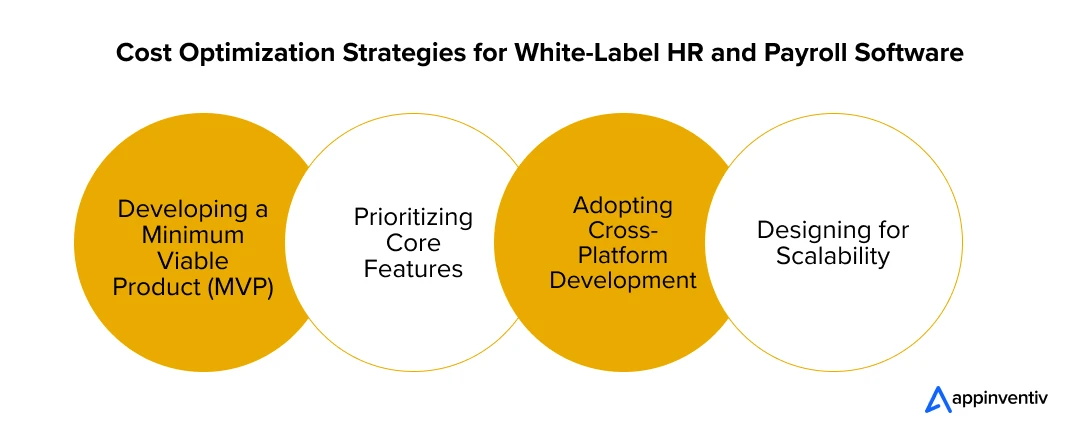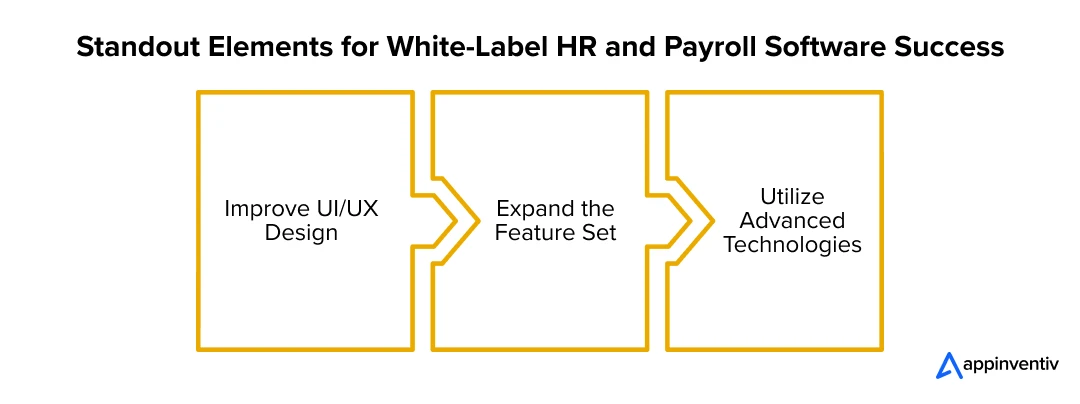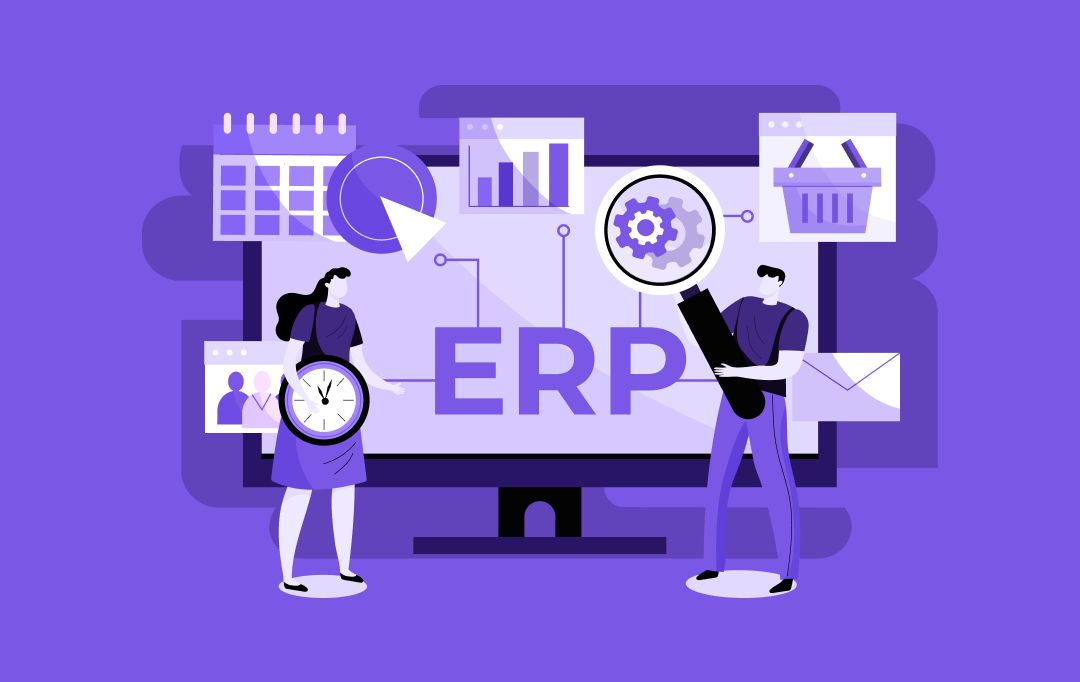- How Does White-Label HR and Payroll Software Work?
- A Comprehensive View of the Costs Involved in Developing White-Label HR and Payroll Software in Australia
- Costs by Complexity Levels
- Costs by Development Stages
- Estimating Costs
- Time and Effort Estimates
- Factors Affecting the White-Label HR Software Development Cost in Australia
- Design Complexity
- Backend Development Complexity
- Third-Party Integrations
- Security Measures
- Compliance Requirements
- Platform Choice
- Feature Complexity
- Advanced Technology Integration
- Hidden App Development Costs for White-Label HR and Payroll Software
- App Maintenance
- App Hosting
- App Promotion and Marketing
- Legal and Licensing Fees
- Effective Cost Optimization Strategies for White-Label HR and Payroll Software
- Developing a Minimum Viable Product (MVP)
- Prioritizing Core Features
- Adopting Cross-Platform Development
- Designing for Scalability
- The Roadmap to White-Label HR And Payroll Software Development
- Conduct Market Research and Analysis
- Define the Core Scope and Features
- Design a User-Friendly Interface
- Build an MVP for Faster Rollout
- Conduct Comprehensive Testing
- Deploy and Integrate Effectively
- Maintain and Update the Software
- Key Features of a White-Label HR and Payroll Software
- Ways to Make White-Label HR and Payroll Software Stand Out
- Improve UI/UX Design
- Expand the Feature Set
- Utilize Advanced Technologies
- Addressing Key Challenges in HR & Payroll Software Development
- Data Security and Privacy Risks
- Scalability and Flexibility
- Navigating Compliance and Regulatory Requirements
- Data Migration Challenges
- Transform Your HR and Payroll Systems with Appinventiv’s White-Label Software
- FAQs
James, a digital marketing company’s HR, handles HR and payroll smoothly, simplifies the process, fulfills compliance requirements, and enhances employee satisfaction. We know this is sheer poetry to your ears. But James revealed a secret sauce behind this success.
Spoiler Alert: White-label HR and Payroll software that offers a fully tailored platform to streamline processes while creating a unique market identity.
If you’re in Australia and considering building your own white-label HR and payroll platform, you’re probably wondering: “What’s the investment?” The answer depends on feature complexity, integrations, and development expertise.
Generally, the white-label HR software development cost in Australia can range between AUD 30,000 and AUD 300,000, with additional expenses for maintenance and upgrades.
In this blog, we will help you understand the cost dynamics and what it takes to turn your idea into a reality in Australia’s booming HR tech space.
How Does White-Label HR and Payroll Software Work?
White-label HR and payroll software enables businesses to deliver HR services under their own brand by utilizing a pre-built solution that can be customized. Companies can personalize the software with branding elements like logos and colors while retaining key enhancements like employee training and development, management, payroll processing, time tracking, and tax calculations. This HR software saves time and resources by offering a ready-made platform tailored to meet business needs.
The HR and payroll software Australia also integrates with other business systems, such as accounting tools and benefits platforms, ensuring seamless operations across various departments. Moreover, these systems come equipped with built-in compliance tools, critical for adhering to Australia’s stringent tax laws, superannuation requirements, and labor regulations.
White-label HR and payroll software is scalable, allowing businesses to grow without disruptions. Additionally, the software provider typically offers ongoing support and maintenance so that the companies can focus on their core operations while outsourcing complex HR tasks.
A Comprehensive View of the Costs Involved in Developing White-Label HR and Payroll Software in Australia
The white-label HR software development cost in Australia encompasses several key factors, including the complexity of features, the technology stack, and necessary integrations. Expenses also depend on the expertise of the development team, compliance needs, and the level of customization required.
Ongoing maintenance, updates, and ensuring data security add to the overall cost. By evaluating these factors, businesses can better plan their budget and develop a solution that meets immediate needs and supports long-term growth and adaptability.
Costs by Complexity Levels
The white-label payroll software development cost in Australia depends largely on its complexity. Basic solutions with essential features can cost less, while advanced or custom solutions demand higher investments due to extensive functionality and scalability.
| Complexity Level | Features | Estimated Cost (AU$) |
|---|---|---|
| Basic | Time tracking, payroll processing | 30,000 – 70,000 |
| Intermediate | Compliance, employee engagement tools | 70,000 – 150,000 |
| Advanced/Custom | Custom workflows, scalability, integrations | 150,000 – 300,000+ |
Costs by Development Stages
The HRMS payroll software development in Australia is divided into multiple stages, each contributing to the overall cost. From planning to post-launch maintenance, every stage has distinct tasks and expenses.
| Development Stage | Description | Estimated Cost (AU$) |
|---|---|---|
| Planning | Requirement analysis, feasibility studies | 5,000 – 10,000 |
| Design | Wireframes, user interface (UI) design | 10,000 – 20,000 |
| Development | Coding, backend integration, feature implementation | 50,000 – 150,000 |
| Launch | Deployment, testing, bug fixes | 10,000 – 30,000 |
| Maintenance | Updates, support, scaling | 10,000 – 20,000 annually |
Estimating Costs
Estimating the white-label HR software development cost in Australia involves analyzing team size, complexity, and development hours. Understanding the required features and technical resources helps calculate an approximate budget.

Time and Effort Estimates
The time required for development is directly proportional to the software’s complexity and the size of the development team. Each stage, from planning to deployment, demands effort across design, coding, testing, and more.
- Basic Software: 4-6 months with a small team.
- Intermediate Software: 6-12 months with a mid-sized team.
- Advanced Software: 12+ months with a larger team.
Factors Affecting the White-Label HR Software Development Cost in Australia
Several factors influence the white-label HR software development cost in Australia, and understanding these factors helps businesses better plan and allocate resources for their HR software development projects. Let’s have a look at those.

Design Complexity
The complexity of the software’s design plays a key role in determining its cost. A custom, user-friendly, and responsive interface demands more design effort and expertise, which increases the HR payroll software price. On the other hand, simpler designs or using templates can keep costs lower but may compromise on branding and user experience.
Backend Development Complexity
Building the backend infrastructure for HR and payroll software, which involves creating APIs, managing servers, and ensuring efficient database operations, is a major cost factor. More complex backend systems require more development time, resources, and testing to ensure scalability, reliability, and smooth data flow.
Third-Party Integrations
Integrating third-party services, such as payment gateways for payroll, social media logins, or GPS tracking, adds to the overall white-label HR software development cost in Australia. These integrations require additional development effort, licensing, and testing to ensure smooth and secure functionality, contributing to higher development expenses.
Security Measures
Since HR and payroll software handles sensitive employee data, implementing strong security measures is essential. Data encryption, secure storage, multi-factor authentication, and regular security updates increase the complexity and white-label payroll software development cost Australia, as higher security standards require advanced tools and expertise.
Compliance Requirements
The software must include compliance features to meet legal and regulatory requirements, such as those set by the Fair Work Act and the Australian Taxation Office (ATO). These features, including tax calculations, compliance checks, and reporting tools, require additional development time and resources, raising the overall white-label HR software development cost in Australia.
Platform Choice
The selection of cloud-based or on-premises platforms greatly influences the white-label payroll software development cost Australia. Cloud-based solutions typically offer scalability and easier maintenance but may involve ongoing hosting fees. On-premises solutions, while providing more control, tend to be more expensive due to the need for infrastructure and maintenance.
Feature Complexity
The number and complexity of features included in the HR and payroll software directly affect the cost of HRMS software development in Australia. Advanced features such as detailed reporting, employee engagement tools, and benefits management demand more development time and specialized expertise, driving up the overall cost of building the software.
Advanced Technology Integration
Advanced technologies like artificial intelligence (AI), machine learning, blockchain, or IoT can elevate the functionality of white-label HR and payroll software. Features like automated payroll, predictive analytics, secure transactions, and real-time device connectivity can be achieved with these technologies. However, their integration requires specialized skills, tools, and infrastructure, significantly increasing the development cost and timeline.
Hidden App Development Costs for White-Label HR and Payroll Software
White-label payroll software development cost Australia also cover hidden costs that significantly impact the overall budget. These often-overlooked costs need to be factored into any comprehensive budget to prevent financial unpredictability down the line.

App Maintenance
Ensuring the software remains up-to-date with industry standards, compliance changes, and bug fixes. This includes regular updates to accommodate evolving HR and payroll regulations in Australia.
App Hosting
Hosting fees for storing sensitive employee and payroll data securely on cloud platforms or dedicated servers. These costs scale with the data volume and the security level required.
App Promotion and Marketing
Marketing efforts to position the software as a reliable solution in the competitive HR and payroll software market. This includes online campaigns, SEO, and product demos for potential clients.
Legal and Licensing Fees
Compliance with Australian payroll regulations, tax codes, and labor laws. Additional costs include acquiring licenses for third-party tools integrated into the software.
Effective Cost Optimization Strategies for White-Label HR and Payroll Software
Adopting cost optimization strategies is crucial to getting the most value from your white-label HR and payroll software investment. These strategies ensure long-term efficiency, balancing functionality with cost-effectiveness. Let’s have a look at those.

Developing a Minimum Viable Product (MVP)
Developing a Minimum Viable Product (MVP) is a cost-effective strategy for white-label HR and payroll software. Businesses can launch quickly by focusing on essential features like employee management, payroll processing, and tax compliance, testing the product in real-world scenarios, and gathering user feedback. This approach minimizes initial white-label HR software development cost in Australia. It allows for the gradual integration of advanced functionalities based on user needs and feedback, ensuring efficient resource allocation.
Prioritizing Core Features
Concentrate on implementing must-have features specific to Australian payroll requirements, such as superannuation contributions, tax calculations, and leave tracking. Avoid integrating overly complex or non-essential features during the initial development phase to keep costs under control.
Adopting Cross-Platform Development
When you hire software developers in Australia, make sure they use cross-platform frameworks like Flutter or React Native to build a single desktop and mobile access codebase. This ensures compatibility across devices and significantly reduces development time and costs.
Designing for Scalability
Build the software with a scalable architecture to handle future growth, such as additional user accounts or complex payroll scenarios. A scalable design reduces the need for costly redesigns and reworks in the long term.
The Roadmap to White-Label HR And Payroll Software Development
The HR payroll software development process in Australia follows a strategic roadmap that takes you from ideation to successful deployment. This roadmap ensures that the final product is high-quality and aligned with your business goals. Here are the crucial steps involved in developing Australian payroll software.
Conduct Market Research and Analysis
Analyze the specific needs of Australian businesses, particularly regarding payroll and HR compliance requirements such as the Fair Work Act, PAYG tax, and other employment laws. Identify the target users, including small businesses, enterprises, and HR agencies, to align the software with their expectations.
Define the Core Scope and Features
List essential features for the software, such as payroll processing, compliance management, employee self-service portals, time tracking, and reporting tools. Consider value-added functionalities like AI-driven analytics, tax forecasting, and seamless integration with existing HR and accounting systems.
Design a User-Friendly Interface
Prioritize the development of an intuitive user interface (UI) and user experience (UX) that caters to HR professionals and employees. A clear, accessible layout with easy-to-navigate dashboards is crucial for ensuring smooth interaction with the software.
Build an MVP for Faster Rollout
Start with a Minimum Viable Product (MVP) to focus on core functionalities. Follow agile methodologies for iterative development, allowing feedback-driven improvements. Modular development can also help in making future upgrades easier.
Conduct Comprehensive Testing
Conduct comprehensive testing across multiple aspects, including functionality, performance, and security. Utilize automated and manual testing methods to ensure the software runs seamlessly across different environments.
Deploy and Integrate Effectively
Roll out the software on the preferred platforms (desktop, web-based, or cloud-based). Ensure the deployment process includes all integrations, such as accounting software, ERP systems, and time management tools.
Maintain and Update the Software
Regularly monitor the software for any issues, provide ongoing technical support, and release updates to enhance its functionality. Incorporate user feedback and adapt to changes in compliance requirements or market trends to keep the software relevant.
Key Features of a White-Label HR and Payroll Software
White-label HR and payroll software offers a range of features that enhance operational efficiency, ensure compliance, and support better decision-making across various functions. Let’s look at some of these key features of HR software development.

- Payroll Automation: Simplify payroll processing with automatic tax calculations, payslip generation, and compliance with payroll regulations, both locally and internationally.
- Tax Filing and Compliance Automation: Automate tax filing with real-time updates to ensure adherence to local, state, and international tax laws, minimizing the risk of penalties.
- Employee Profile Management: Manage employee data, performance, and benefits in a centralized platform, streamlining HR operations and improving overall efficiency.
- Benefits Management: Track and manage employee benefits such as health insurance and retirement plans with easy-to-use tools that enhance employee satisfaction.
- Workforce Scheduling and Shift Management: Create and manage employee schedules, track shift changes, and ensure that departments are adequately staffed.
- Employee Self-Service Portal: Provide employees with a portal to update personal details, submit time-off requests, access payslips, and monitor benefits, reducing administrative workload.
- Direct Deposit Integration: Integrate directly with banks for fast, secure employee salary deposits, ensuring timely and error-free payments.
- Customizable Dashboards: Tailor dashboards to display key performance indicators (KPIs) and metrics that provide real-time insights into HR and payroll activities.
- Reporting and Analytics: Generate in-depth reports on payroll costs, employee performance, and HR trends to help businesses make informed, data-driven decisions.
- Multi-Currency and Multi-Language Support: Streamline payroll management for global businesses with support for multiple currencies and languages, making it easier to manage international teams.
- Document Management: Securely store and manage HR documents such as contracts, policies, and tax forms, with easy retrieval for audits and compliance checks.
Ways to Make White-Label HR and Payroll Software Stand Out
To make your white-label HR and payroll software stand out, focusing on delivering a solution that combines innovation, reliability, and customization is essential. Let’s explore the key strategies to ensure your HR management system software differentiates itself in the market.

Improve UI/UX Design
A polished user interface and seamless user experience are essential to making the software intuitive and user-friendly. Implement responsive designs, streamlined navigation, and modern aesthetics to ensure smooth device interaction. Adding personalized features like customizable dashboards further enhances usability and creates a tailored user experience.
Expand the Feature Set
To elevate the software’s capabilities, incorporate advanced functionalities like predictive analytics, multi-currency payroll processing, and self-service employee portals.
Features such as automated compliance tracking and real-time notifications make managing HR and payroll more efficient while ensuring scalability for businesses of all sizes.
Utilize Advanced Technologies
Integrate cutting-edge technologies like AI for automation, machine learning for predictive insights, and blockchain for secure and transparent data management. These innovations work as a complete hr management system software that enhances payroll efficiency, improves decision-making, and future-proofs the software by delivering robust and intelligent HR solutions.
Addressing Key Challenges in HR & Payroll Software Development
Successfully developing HR and payroll software involves overcoming several obstacles, but these can be efficiently addressed with the right strategies. Let’s have a look at the challenges involved in implementing white-label HR software and solutions to overcome those:

Data Security and Privacy Risks
The sensitive nature of HR and payroll data, such as personal and financial information, makes these systems prime targets for cyberattacks. Ensuring robust security while managing data privacy can be challenging.
Solution: Apply strong encryption methods, multi-factor authentication, and regular security assessments. Use best practices for data anonymization, and opt for secure cloud services with built-in security features to protect sensitive data from unauthorized access.
Scalability and Flexibility
As businesses grow, HR and payroll software must scale to handle larger volumes of data and new features, which can result in performance degradation or the need for constant system overhauls.
Solution: Utilize cloud-based infrastructure that allows for seamless scalability. Adopt a modular and microservices-based architecture to enable easy adjustments and the ability to scale the system as business needs change without compromising performance.
Navigating Compliance and Regulatory Requirements
HR and payroll software must stay current with frequently changing tax laws, labor regulations, and varying regional compliance standards. This complexity can be difficult to manage, especially when handling a global workforce.
Solution: Implement regular updates and integrations with real-time regulatory information. Collaborate with legal experts to ensure compliance and use automation to streamline tax calculations and compliance checks, ensuring the software remains up-to-date and in line with local and international regulations.
Data Migration Challenges
Migrating data from legacy systems to new HR and payroll software can be complex and risky, especially when dealing with large volumes of sensitive information.
Solution: Create a comprehensive migration plan with testing and verification stages to ensure data integrity. Use automated tools for data mapping and validation and support businesses during the transition period to minimize disruptions.
Transform Your HR and Payroll Systems with Appinventiv’s White-Label Software
Managing HR and payroll can be daunting, especially when the business scales. HRMS software development in Australia provides a strategic advantage by delivering a fully customizable platform that automates essential processes while ensuring data security and compliance.
Appinventiv Australia is a trusted company providing custom software development services in Australia that can help you leverage the full potential of white-label HR and payroll software to improve your operations and transform your HR processes into a competitive advantage.
While the white-label HR software development cost in Australia can vary depending on features, integrations, and complexity, the investment is invaluable for businesses seeking efficiency, flexibility, and seamless scalability.
With our custom software development services in Australia, we can ensure a tailored, future-ready platform that integrates with your existing systems and seamlessly meets your unique requirements. This can streamline workflows, enhance accuracy, and improve reporting—all while reducing the burden of manual tasks.
Contact us to explore the flexibility and ease of tailoring White-Label HR and Payroll software to meet your business requirements. We’ll deliver a scalable solution designed to drive next-level productivity.
FAQs
Q. What is white-label payroll software development cost Australia?
A. HR software costs in Australia typically range from AUD 30,000 to AUD 300,000. Key factors influencing the price include the software’s complexity, the features required, the number of users, and the deployment type—whether cloud-based or on-premises. These factors determine the overall investment needed for an HR solution. Contact our experts immediately to learn more about the white-label HR software development cost in Australia!
Q. How long does developing white-label HR & payroll software in Australia take?
A. The development timeline for white-label HR and payroll software varies based on the features and complexity:
- Basic functionality (e.g., time tracking, payroll processing): 4-6 months.
- Advanced features (e.g., compliance, employee engagement tools): 6-12 months.
- Fully customized and scalable solutions: 12+ months.
The duration depends on the software’s complexity, team size, and whether it’s built from scratch or using existing frameworks.
Q. How do you choose the right software development team in Australia?
A. Selecting the right software development team involves several key considerations:
Portfolio: Evaluate past projects to ensure quality and alignment with your goals.
Technical Skills: Confirm proficiency in the required technologies and frameworks.
Customization: Choose developers who can tailor the solution to your needs.
Experience: Prioritize teams with expertise in HR and payroll systems.
Budget and Timeline: Opt for a team that provides transparent pricing and realistic delivery schedules.
Communication: Look for a team with clear and responsive communication.
Q. What are the benefits of white-label HR and payroll software development?
A. White-label HR and payroll software development offers several key benefits:
- Cost-Effective: It saves on development costs by using pre-built solutions, reducing time and expenses.
- Scalable: The flexible software allows for future growth and feature additions.
- Customizable Branding: Businesses can personalize the software to align with their brand.
- Quick Implementation: Leveraging white-label software speeds up the time-to-market.
- Compliance: The software often includes built-in compliance features, ensuring regulation adherence.
- Focus on Core Operations: It reduces the need to maintain complex systems, letting businesses focus on growth.



Custom Development or White Label Solutions: Which is Right for Your Business?
Key takeaways: 77% of companies are prioritizing digital transformation; the right tech approach is crucial for staying competitive. Custom development offers tailored solutions for unique needs, flexibility, and long-term scalability. Whereas, white-label solutions provide quick market entry, cost-efficiency, and easy customization for standard needs. Appinventiv’s expertise helps you navigate custom development vs white-label to choose…

ERP Integration in Australia - Why It Is Essential and How to Do It Right
Key takeaways: ERP integration enables operational efficiency, reduced costs, and enhanced decision-making. Healthcare, finance, manufacturing, retail, and all the other sectors are benefiting from ERP integrations in Australia. While ERP integration can be costly, ranging from AUD 45,000 - AUD 450,000, it leads to significant long-term savings and scalability. Compliance with Australian regulations is critical,…

Predictive Analytics Software Development - Features, Benefits, Use Cases, Process, and Cost
Key Takeaways Predictive analytics helps businesses shift from “what has happened” to "what will happen," enabling proactive strategies rather than reactive ones. Real-time analytics and AI integration are driving the growth of predictive analytics, making it more accurate, accessible, and critical for business success. Custom predictive analytics solutions can enhance customer satisfaction, reduce costs, and…


















